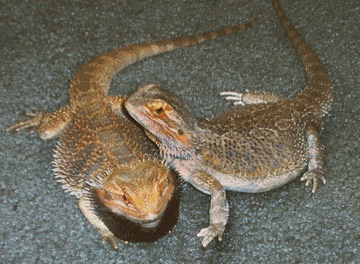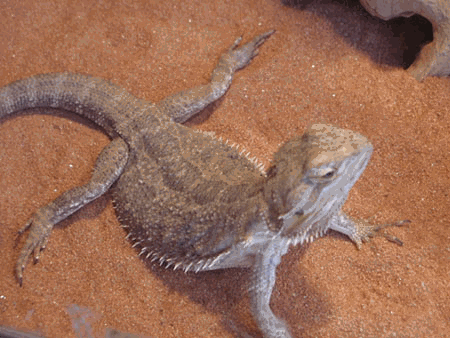|
Care of your Bearded Dragon

Hatchlings- The hatchlings can be a bit more delicate than many other lizard species. There are a number of details that you must pay careful attention to be successful in raising a baby bearded dragon. They do quite well on a diet of crickets of an appropriate size (for hatchlings, º inch crickets or smaller), small mealworms, waxworms, and greens and other vegetables. Often, crickets or other items that are too large will cause digestive problems in the small gut of the baby dragon leading to a seemly mysterious death. The little dragon will be fine one day and listless the next. The right size food item will be no longer than _ the width of the lizards own head. When in doubt, err to the small side and resist feeding larger food items for as long as you can. It is important to supply vitamins and minerals to your growing dragon. This can be accomplished by “gut-loading” crickets by feeding them such items as orange slices, carrots, salad greens, fish flake food, or a commercially available cricket food prior to giving them to your lizard. Additionally, the crickets can be dusted (coated in powder) with a quality commercial vitamin/mineral powder just before providing them to your dragon to eat. Hatchlings should be fed every day to maintain a healthy growth rate. Some hatchling will accept fruits and vegetables early on, while others are only interested in the food that moves. Keep a small water bowl available at all times, just be sure to clean it regularly. Your baby dragon may not recognize standing water in a bowl, so it is a good idea to mist or lightly spray the dragon daily to be sure it doesn’t become dehydrated.
Adults- The adults are a medium to large size (18 to 24”), active lizard that will require a good amount of space. As far as the cage goes, the larger the better. Use larger prey items (large crickets, superworms, pinkie mice, etc) and offer more vegetables and some fruits. Adults will consume a good amount of food and feedings can be once a day, four to six times a week. They don’t need vitamin supplementation quite as often either, maybe with every other to every third feeding. Breeding females can be fed extra and supplied with vitamin and mineral supplements more often to compensate for reproductive energy expenditures. You can expect your dragon to live at least 8 to 10 years or more with proper care and nutrition.
 General- The Inland Bearded Dragon comes from the hot, dry deserts and of Australia and is well adapted to desert life. They are active at daybreak and remain active throughout the daylight hours, sleeping soundly at night. A 10-gallon tank will comfortably house a single baby to juvenile for about 8 months or so. Beyond that, these active lizards will require more room. A 55 gallon tank will be sufficient for a pair of adult bearded dragons. Paper towels or newspaper make for quick and easy cleaning and eliminates the possibility of baby dragons ingesting any sand or gravel. The adults, however, can be kept on a sand (or Calci-Sand) substrate without problems. Add some rocks, branches, or other cage furniture to make an interesting landscape for your dragon to explore. Provide dragons with an area where they can hide, such as a rock shelter or hide-box. Although a heat pad, or thermostat controlled heat rock can work as a heat source, we prefer and recommend heat bulbs in a reflector dome as a primary source of heat. Proper lighting is essential to the long term health of your dragon. In addition to a heat bulb, you will need to provide a UV (ultraviolet) light source so that your dragon can properly synthesize vitamins and metabolize calcium in its body. Again, this is achieved using a specialty light bulb. Recent advances in commercially available UV producing bulbs have made it very easy and much cheaper to provide the right lighting. Don’t skimp on the lighting for you dragon, it will die without the right lighting. General- The Inland Bearded Dragon comes from the hot, dry deserts and of Australia and is well adapted to desert life. They are active at daybreak and remain active throughout the daylight hours, sleeping soundly at night. A 10-gallon tank will comfortably house a single baby to juvenile for about 8 months or so. Beyond that, these active lizards will require more room. A 55 gallon tank will be sufficient for a pair of adult bearded dragons. Paper towels or newspaper make for quick and easy cleaning and eliminates the possibility of baby dragons ingesting any sand or gravel. The adults, however, can be kept on a sand (or Calci-Sand) substrate without problems. Add some rocks, branches, or other cage furniture to make an interesting landscape for your dragon to explore. Provide dragons with an area where they can hide, such as a rock shelter or hide-box. Although a heat pad, or thermostat controlled heat rock can work as a heat source, we prefer and recommend heat bulbs in a reflector dome as a primary source of heat. Proper lighting is essential to the long term health of your dragon. In addition to a heat bulb, you will need to provide a UV (ultraviolet) light source so that your dragon can properly synthesize vitamins and metabolize calcium in its body. Again, this is achieved using a specialty light bulb. Recent advances in commercially available UV producing bulbs have made it very easy and much cheaper to provide the right lighting. Don’t skimp on the lighting for you dragon, it will die without the right lighting.
Other Helpful Info:
Þ Always buy a healthy captive bred animal and learn as much as you can from the source that you are buying it from, such as age, sex, what is it eating, etc.
Þ Find a local veterinarian who is knowledgeable about reptiles before any problems arise!
Þ Buy a good book about Bearded Dragons or at least a book with a decent section about these animals and keep it on hand for reference. This care sheet contains only initial information to get you started and is by no means complete.
Þ Enjoy your Bearded Dragon! These are awesome and intriguing pets.
|